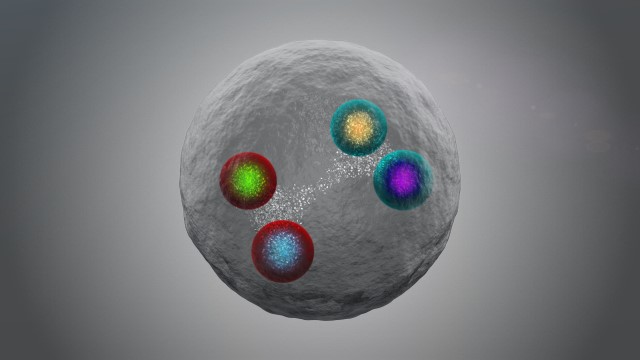
Charmed existence: conceptual illustration of a tetraquark. (Courtesy: CERN)
The first tetraquark comprising all charm quarks and antiquarks may have been spotted by physicists working on the LHCb experiment on the Large Hadron Collider (LHC) at CERN. The exotic hadron was discovered as it decayed into two J/ψ mesons, each of which is made from a charm quark and charm antiquark. The particle appears to be the first known tetraquark to be made entirely of “heavy quarks”, which are the charm and beauty quarks (but not the top quark, which is the heaviest quark but does not form hadrons).
"Particles made up of four quarks are already exotic, and the one we have just discovered is the first to be made up of four heavy quarks of the same type, specifically two charm quarks and two charm antiquarks," explains Giovanni Passaleva, who is just stepping down as spokesperson for LHCb. “Up until now, the LHCb and other experiments had only observed tetraquarks with two heavy quarks at most and none with more than two quarks of the same type."
The new tetraquark is dubbed X(6900), with the number referring to its mass of 6900 MeV/c2 (6.9 GeV/c2). The X denotes the fact that LHCb physicists are not yet certain about key properties of the particle including its spin, parity and quark content.
Hadrons are made of two or more bound quarks or antiquarks. Mesons comprise a quark and antiquark, whereas baryons such as protons and neutrons comprise three quarks. However, nature does not stop at three quarks and several tetraquarks (two quarks and two antiquarks) and pentaquarks (four quarks and an antiquark) have been discovered.
Predicted Mass
Evidence for the X(6900) tetraquark comes as a bump in the mass distribution spectrum of pairs of J/ψ particles produced by proton-proton collisions at the LHC. The bump has a statistical significance of more than 5σ, which is considered a discovery in particle physics. The bump is centred at 6.9 GeV/c2, which is well within the 5.8–7.4 GeV/c2 mass range predicted for a tetraquark comprising two charm quarks and two charm antiquarks.
An important question surrounding tetraquarks and pentaquarks is the nature of their internal structures. This is defined by strong-force interactions between quarks, which are extremely difficult to calculate. In a tetraquark, for example, the quarks and antiquarks could all be tightly bound together – or they could be arranged as two quark–antiquark pairs loosely bound in a molecule-like structure. Or indeed, a tetraquark could have a configuration somewhere between these two extremes.
"This new result provides further crucial evidence on the behaviour of quarks and how they interact through the strong force," says Tim Gershon of the University of Warwick and spokesperson for LHCb-UK, adding "It will undoubtedly be of great interest to theorists working to better understand exotic hadrons." "Data that we will collect with an upgraded [LHCb] detector in the coming years will allow us to widen the search for further such particles, and may resolve once and for all the debate over their substructure."



